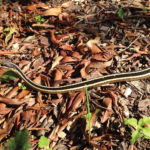We live in Woodbrook, abutting the school yard. A month or so ago, whoever mowed the school grounds left several acres unmowed and erected signs saying, “Conservation Mowing.” They were letting the grass grow to somehow benefit wildlife. That’s total rubbish. The grass they have allowed to grow is knee high fescue, which actually is a detriment to wildlife habitat. It’s the single reason that … [Read more...]
Chronic Wasting Disease
By Bruce Ingram Understandably, chronic wasting disease (CWD) is a topic much on the minds of Virginia sportsmen and wildlife watchers. Alexandra Lombard, wildlife health coordinator for the Virginia Department of Wildlife Resources (DWR), provided an update. “Right now, we have CWD in nine counties in Northern Virginia and in four counties in Southwest Virginia,” she said. “The disease is … [Read more...]
Long Live the Loggerhead
By Molly Kirk/DWR You might not think of sea turtles when you think of the Virginia Department of Wildlife Resources (DWR), but the agency is responsible for those species as well. The loggerhead turtle is the most abundant species of sea turtle that nests in the United States, but the Northwest Atlantic population is listed as threatened under the Endangered Species Act, as of … [Read more...]
Restore Wildlife in Your Back Yard
By Molly Kirk When you make decisions about how to maintain your yard and property this fall, keep in mind that there are many different species of wildlife that call your yard home. While raking leaves and mowing tall grass might create a neater “look” for your yard, leaving your yard with a somewhat messier appearance creates valuable food and shelter for not only birds, but also pollinators, … [Read more...]
The Threat of Alabama Bass
By Bruce Ingram If there is a common topic among the Virginia Department of Wildlife Resources’ (DWR) regional fisheries managers, it is their concerns about the presence—and spread—of Alabama bass. Scott Smith, who is based at the DWR Region 2 office in Forest, Virginia, is no different. “Alabama bass have now been found at Philpott, Buggs Island, and Martinsville Reservoir and … [Read more...]
Beware of the James
The James is a powerful and dangerous river. Last week, an Albemarle County family lost three children to drowning after a fateful attempt to swim. I can personally attest to the strength of this mighty river. When I first moved to Charlottesville, I asked about river fishing in these parts and was told to go to the James. It was a beautiful, charming river and I fished from the bank, … [Read more...]
Can We Save the Bay?
No one in then Virginia political hierarchy seems concerned that the menhaden reduction fleet based in Reedville is taking food from the mouths of stripers, trout, and other Virginia gamefish, but maybe they’ll pay attention as osprey nests begin to disappear. Ospreys feed heavily on menhaden and when vast schools of the oily baitfish instantly disappear, the food in that entire area for these … [Read more...]
Short-Toothed Mountain Mint
I wrote about this amazing plant last year, but it is worth a repeat. Short-Toothed Mountain Mint is the most astounding pollinator attractor I have ever seen. We have two plants in their second year and at any given time throughout the day there will be 25 to 50 bees – mostly honeybees – on each plant. I have seen more honeybees on these plants in one day than I have seen in my yard for … [Read more...]
The Eagle’s Return
By Molly Kirk/DWR There is no more iconic emblem of the impact of the Endangered Species Act (ESA) than the bald eagle. The national bird since 1782, this majestic species serves as a symbol not only of the country, but also of the success of endangered species protection. “I can’t really think of a greater wildlife management success story; it’s one of the biggest,” said Jeff Cooper, … [Read more...]
Living With Snakes
(A common ribbon snake) By DWR Snake and Lizard Guide Snakes occur in many places, including yards and homes in rural and suburban areas. Most species are small and secretive and are seldom seen by homeowners, but larger snakes can create quite a commotion. If you live near a creek, woods, or fields, snakes may occasionally show up in your yard. The best way to deal with snakes is to educate … [Read more...]
- « Previous Page
- 1
- …
- 3
- 4
- 5
- 6
- 7
- …
- 14
- Next Page »









